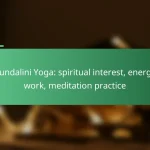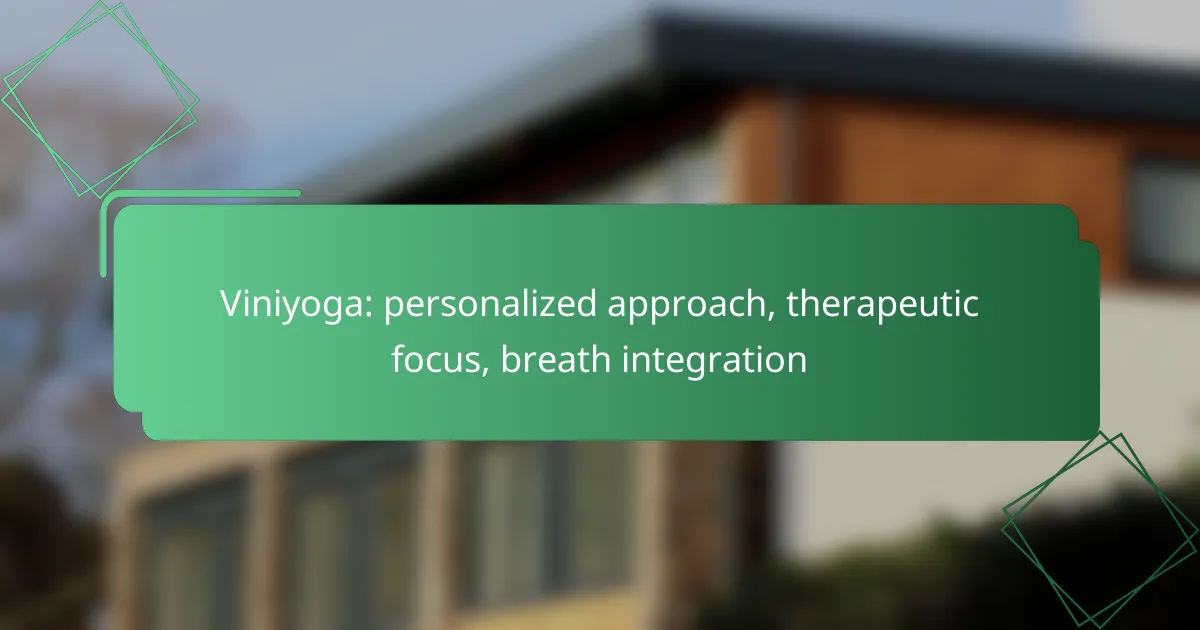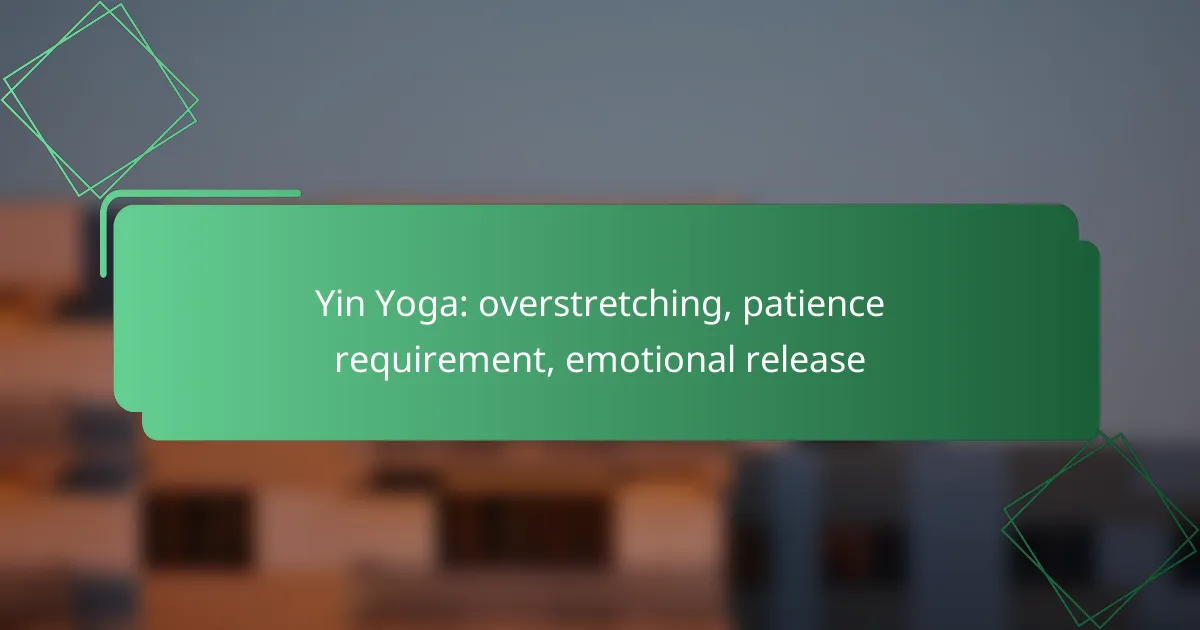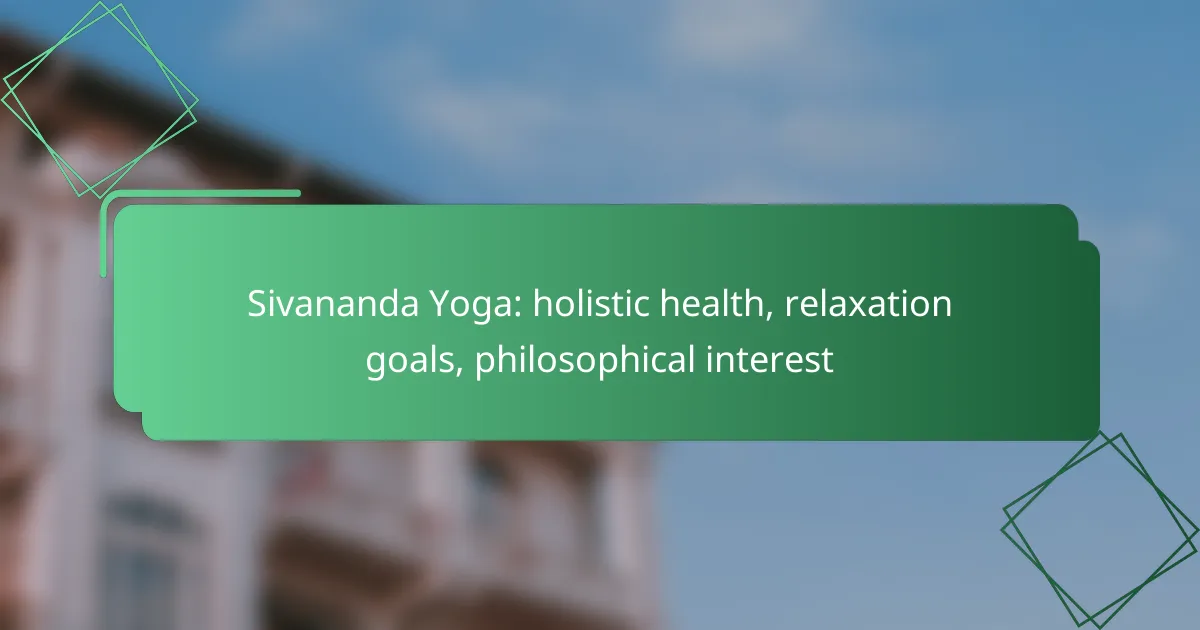Viniyoga is a personalized approach to yoga that emphasizes adaptability and breath integration, catering to individual needs for enhanced physical and mental well-being. With a strong therapeutic focus, it tailors practices to address various physical and emotional conditions, making it a beneficial choice for practitioners seeking a customized experience.
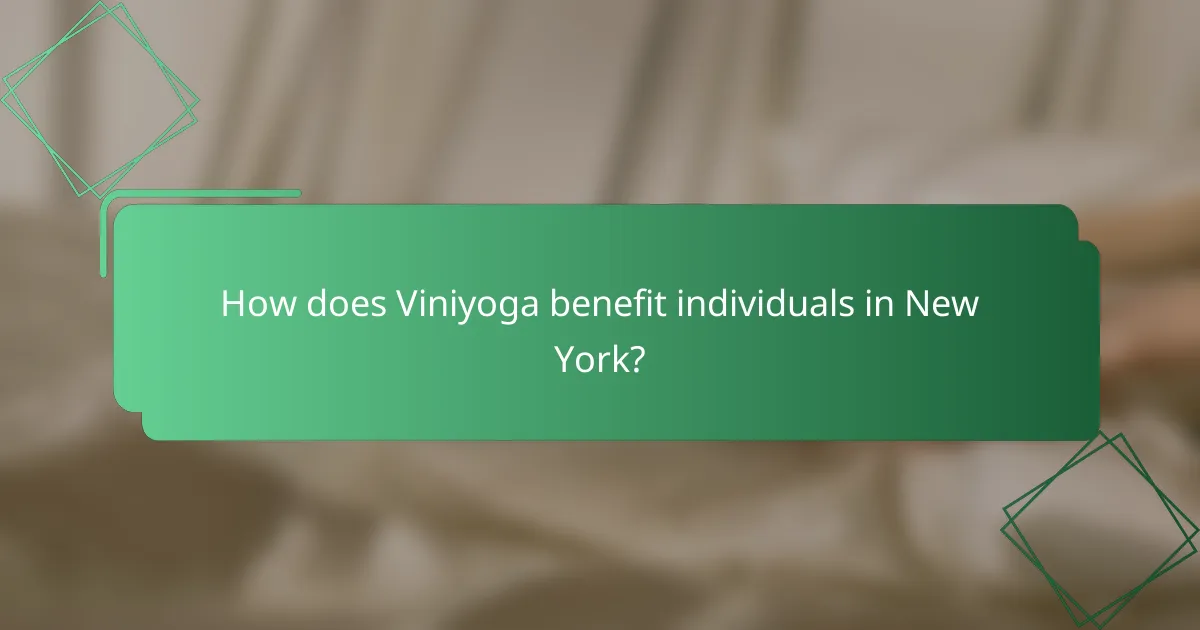
How does Viniyoga benefit individuals in New York?
Viniyoga offers personalized approaches that cater to individual needs, making it particularly beneficial for residents of New York. Its therapeutic focus and integration of breath techniques help enhance physical and mental well-being.
Personalized therapeutic sessions
Viniyoga emphasizes tailored sessions that address specific health concerns and personal goals. In New York, practitioners often conduct initial assessments to understand individual needs, which can include physical limitations, stress levels, or chronic pain. This customization allows for a more effective practice that evolves with the individual.
During sessions, instructors may incorporate various techniques such as gentle movements, specific postures, and breathing exercises that align with the participant’s therapeutic objectives. This personalized approach can lead to significant improvements in overall health and wellness.
Improved breath integration techniques
Breath integration is a core component of Viniyoga, focusing on the connection between breath and movement. In New York, practitioners learn to use breath as a tool to enhance physical performance and emotional stability. Techniques often involve synchronized breathing with movements, which can help reduce anxiety and improve focus.
Incorporating breath work into daily routines can lead to better stress management and increased energy levels. Simple practices, such as diaphragmatic breathing or extended exhalations, can be easily integrated into busy lifestyles, making them accessible for New Yorkers.
Enhanced mental well-being
Viniyoga’s therapeutic focus contributes significantly to enhanced mental well-being. By combining physical postures with breath work, individuals often experience reduced stress and improved emotional resilience. In a fast-paced city like New York, these benefits can be particularly valuable for managing daily pressures.
Regular practice can lead to increased mindfulness and self-awareness, helping individuals navigate challenges with greater ease. Engaging in Viniyoga can foster a sense of community and support, further enhancing mental health through shared experiences and connections with others.
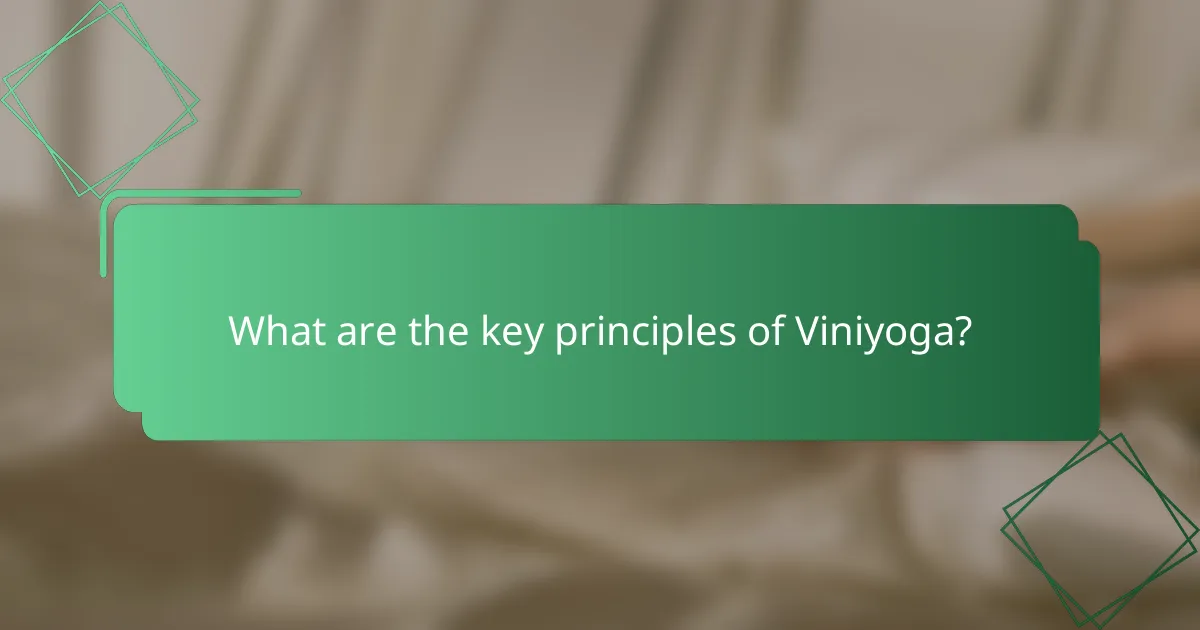
What are the key principles of Viniyoga?
Viniyoga is a personalized approach to yoga that emphasizes adaptability, breath integration, and therapeutic benefits. It focuses on tailoring practices to meet individual needs, making it suitable for various physical and emotional conditions.
Adaptability to individual needs
Viniyoga is designed to accommodate the unique requirements of each practitioner. This adaptability means that poses, sequences, and breathing techniques can be modified based on a person’s physical abilities, health conditions, and personal goals.
For example, someone recovering from an injury may require gentler movements, while a more experienced practitioner might engage in more challenging postures. This individualized approach ensures that everyone can benefit from yoga, regardless of their starting point.
Focus on breath and movement
In Viniyoga, breath is considered a vital component that enhances movement and promotes mindfulness. Practitioners learn to synchronize their breath with their movements, creating a flowing practice that fosters deeper awareness and relaxation.
This integration of breath and movement helps to cultivate a sense of calm and presence, making it easier to manage stress and anxiety. Techniques such as pranayama (breath control) are often incorporated to deepen this connection.
Therapeutic applications
Viniyoga has significant therapeutic applications, making it a valuable tool for addressing various health issues. It can help alleviate conditions such as chronic pain, anxiety, and stress-related disorders by providing tailored practices that promote healing and well-being.
For instance, individuals with respiratory issues may benefit from specific breath techniques, while those with mobility challenges can focus on gentle movements. Working with a qualified instructor can enhance these therapeutic benefits, ensuring that practices are safe and effective.

How to choose a Viniyoga instructor in Los Angeles?
Choosing a Viniyoga instructor in Los Angeles involves evaluating their qualifications, teaching style, and client feedback. Focus on finding someone who aligns with your personal goals and therapeutic needs.
Check credentials and experience
Start by verifying the instructor’s credentials, such as certifications from recognized yoga organizations. Look for instructors with specific training in Viniyoga, which emphasizes a personalized and therapeutic approach.
Experience matters, too. Instructors with several years of practice and teaching can offer deeper insights and tailored guidance, making your sessions more effective.
Evaluate teaching style and approach
Each Viniyoga instructor may have a unique teaching style, so it’s essential to find one that resonates with you. Consider whether they focus on breath integration, personalized sequences, or therapeutic applications in their classes.
Attend a trial class if possible. This allows you to experience their approach firsthand and determine if it matches your learning preferences and therapeutic goals.
Assess client testimonials
Client testimonials can provide valuable insights into an instructor’s effectiveness and teaching style. Look for reviews that highlight their ability to customize sessions and address specific health concerns.
Online platforms and local yoga communities in Los Angeles can be excellent resources for gathering feedback. Pay attention to recurring themes in testimonials, such as improvements in health or overall satisfaction with the instructor’s guidance.

What are the common practices in Viniyoga?
Viniyoga emphasizes personalized practices tailored to individual needs, focusing on therapeutic benefits and breath integration. Common practices include breath-centered movement sequences, mindfulness techniques, and therapeutic adjustments for injuries.
Breath-centered movement sequences
Breath-centered movement sequences in Viniyoga are designed to synchronize breath with physical postures, enhancing the overall experience. This approach allows practitioners to cultivate awareness and control over their breath, which can lead to improved relaxation and focus.
Typically, these sequences involve slow, deliberate movements that correspond with inhalation and exhalation. For example, a common practice might include raising the arms overhead while inhaling and lowering them while exhaling. This rhythm supports a deeper connection between body and mind.
Mindfulness and meditation integration
Mindfulness and meditation are integral to Viniyoga, promoting mental clarity and emotional balance. Practitioners often incorporate mindfulness techniques during movement, encouraging a heightened awareness of sensations and thoughts.
For instance, a session may begin with a few minutes of seated meditation to center the mind, followed by mindful movement. This practice helps in cultivating a sense of presence and can significantly enhance the therapeutic effects of the physical postures.
Therapeutic adjustments for injuries
Viniyoga places a strong emphasis on therapeutic adjustments, making it suitable for individuals with injuries or specific health concerns. Instructors often modify poses to accommodate various physical limitations, ensuring safety and comfort during practice.
Common adjustments might include using props like blocks or straps to support the body or altering the depth of a pose to prevent strain. Practitioners are encouraged to communicate their needs, allowing for a customized approach that promotes healing and recovery.

What is the history of Viniyoga?
Viniyoga is a personalized approach to yoga that emphasizes therapeutic applications and breath integration, rooted in ancient Indian traditions. Its evolution reflects a blend of historical practices and modern adaptations, making it relevant for contemporary practitioners seeking holistic well-being.
Origins in ancient Indian traditions
The roots of Viniyoga can be traced back to ancient Indian texts and practices, particularly within the context of yoga as a spiritual discipline. It draws from the teachings of the Yoga Sutras of Patanjali and the Hatha Yoga Pradipika, which emphasize the importance of breath (pranayama) and individualized practice.
These traditions recognized the need for adapting yoga techniques to suit individual needs, allowing practitioners to engage with yoga in a way that promotes personal growth and healing.
Development by T.K.V. Desikachar
T.K.V. Desikachar, the son of the renowned yogi Krishnamacharya, played a pivotal role in shaping Viniyoga as a distinct practice in the 20th century. He emphasized the importance of tailoring yoga practices to the individual, considering factors such as age, health, and personal goals.
Desikachar’s teachings integrated breath with movement, fostering a therapeutic focus that aimed to address specific physical and emotional challenges. His work has influenced countless yoga teachers and practitioners worldwide.
Influence on modern yoga practices
Viniyoga has significantly impacted modern yoga by promoting a more personalized and therapeutic approach. Many contemporary yoga styles now incorporate principles of Viniyoga, such as breath-centered practices and individualized sequences that cater to students’ unique needs.
This influence is evident in various yoga schools and teacher training programs that prioritize the integration of breath and movement, encouraging practitioners to explore their own bodies and experiences. As a result, Viniyoga continues to be a vital part of the evolving landscape of yoga today.
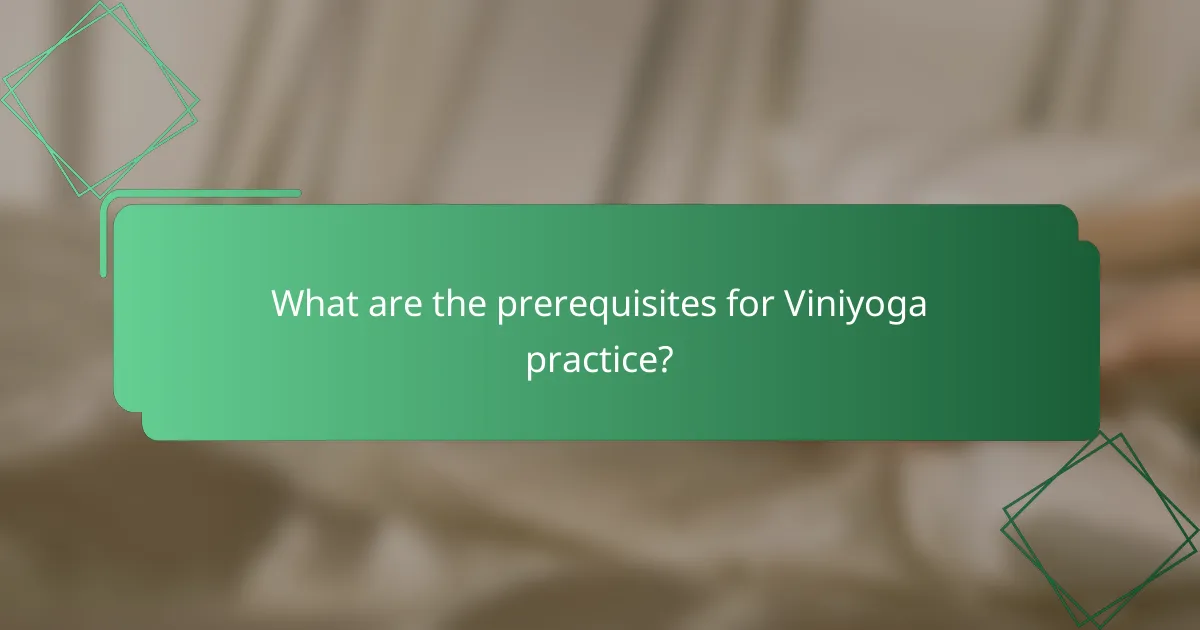
What are the prerequisites for Viniyoga practice?
To engage in Viniyoga practice, individuals should have a basic understanding of yoga principles and a willingness to explore their personal needs. These prerequisites help tailor the practice to each person’s unique circumstances and goals.
Basic understanding of yoga principles
A foundational grasp of yoga principles is essential for Viniyoga. This includes knowledge of asanas (postures), pranayama (breath control), and the philosophical underpinnings of yoga. Familiarity with these concepts allows practitioners to adapt their practice effectively.
Beginner practitioners should consider attending introductory classes or workshops to build their understanding. Resources such as books and online courses can also provide valuable insights into yoga’s core tenets.
Willingness to explore personal needs
Viniyoga emphasizes a personalized approach, making it crucial for practitioners to be open to exploring their individual needs. This exploration can involve assessing physical limitations, emotional states, and personal goals related to health and wellness.
Practitioners should regularly reflect on their experiences and adjust their practice accordingly. Keeping a journal or discussing progress with a teacher can facilitate this self-exploration, ensuring that the practice remains relevant and beneficial.

